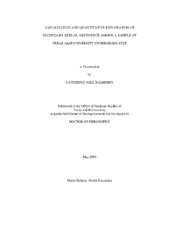| dc.description.abstract | This dissertation explored the prevalence of and predictors of secondary sexual
abstinence (following sexual initiation) in a sample of Texas college students. A
qualitative phase of research (N=20) was conducted through face-to-face interviews, and
data provided the foundation for development of a web-based survey administered to a
sample of 1,133 undergraduates during the quantitative phase of the research. Data
produced several key findings. When explaining motivations for secondary abstinence,
interview participants most commonly mentioned religion, but also cited fear of physical
consequences, past negative experiences with sexual activity, wanting to â saveâ sex for
the right person, desire to honor a partnerâ s wish to abstain, desire to maintain power in a
relationship, and identification of dissonance between personal values and behavior.
Participants described religious factors, friends, parents/family, avoidance of physical
consequences, feelings about self, success in school, support from partner, and lack of
current temptation as supportive of abstinence. Friends, alcohol consumption,
perceptions of sex being widely accepted, and physical attraction and opportunity for
sexual activity were considered non-supportive or hindering. Quantitative survey results revealed a 12.5% prevalence rate of secondary abstinence. Predictors of secondary
abstinence (following sexual initiation) included positive attitude toward abstinence
(OR=1.010; p=.002), subjective norm supporting abstinence (OR=1.010; p=.001),
greater religious ties (OR=1.019; p=.046), and previous negative sexual experiences
(OR=1.051; p=.020). Participation in an abstinence education program significantly
reduced the likelihood of secondary abstinence (OR=.572; p=.049). Fewer perceived
barriers (=-.331; p<.000), less environmental manipulation (=-.230; p=.035), and greater
religious ties (=.301; p=.003) were significant predictors of self-efficacy for abstinence.
Terminology for secondary abstinence was explored in both phases. Qualitative data
revealed â virgin,â â secondary virgin,â â renewed virgin,â â born-again virgin,â and
â abstinentâ were terms used for secondary abstinence. Quantitative data revealed â bornagain
virginâ was the most familiar term, but secondary abstainers most often described
themselves as â abstinentâ (49.3%). Findings provide an estimate of secondary
abstinence prevalence in this sample, supply insight into motivations for the practice,
and suggest focal points for future research (including impacts of abstinence education
on sexually experienced youth). | en |


